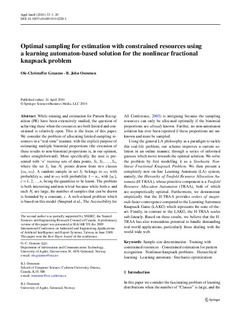| dc.description.abstract | While training and estimation for Pattern Recognition (PR) have been extensively studied, the question of achieving these when the resources are both limited and constrained is relatively open. This is the focus of this paper. We consider the problem of allocating limited sampling resources in a “real-time” manner, with the explicit purpose of estimating multiple binomial proportions (the extension of these results to non-binomial proportions is, in our opinion, rather straightforward). More specifically, the user is presented with ‘n’ training sets of data points, S 1,S 2,…,S n , where the set S i has N i points drawn from two classes {ω 1,ω 2}. A random sample in set S i belongs to ω 1 with probability u i and to ω 2 with probability 1−u i , with {u i }, i=1,2,…n, being the quantities to be learnt. The problem is both interesting and non-trivial because while both n and each N i are large, the number of samples that can be drawn is bounded by a constant, c. A web-related problem which is based on this model (Snaprud et al., The Accessibility for All Conference, 2003) is intriguing because the sampling resources can only be allocated optimally if the binomial proportions are already known. Further, no non-automaton solution has ever been reported if these proportions are unknown and must be sampled.
Using the general LA philosophy as a paradigm to tackle this real-life problem, our scheme improves a current solution in an online manner, through a series of informed guesses which move towards the optimal solution. We solve the problem by first modelling it as a Stochastic Non-linear Fractional Knapsack Problem. We then present a completely new on-line Learning Automata (LA) system, namely, the Hierarchy of Twofold Resource Allocation Automata (H-TRAA), whose primitive component is a Twofold Resource Allocation Automaton (TRAA), both of which are asymptotically optimal. Furthermore, we demonstrate empirically that the H-TRAA provides orders of magnitude faster convergence compared to the Learning Automata Knapsack Game (LAKG) which represents the state-of-the-art. Finally, in contrast to the LAKG, the H-TRAA scales sub-linearly. Based on these results, we believe that the H-TRAA has also tremendous potential to handle demanding real-world applications, particularly those dealing with the world wide web. | en_US |
